Looking for the “Do’s and Don’ts” for your upcoming Hawai’i vacation? This article will help you become familiar with local laws and guidelines designed to protect the environment and preserve our natural resources.
What not to bring:
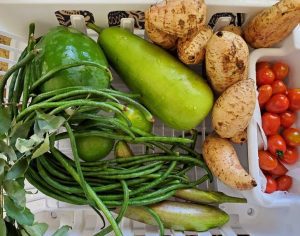
Outside produce, plants, dirt, and non-native bugs have decimated many natural crops across the islands
Produce, flowers, plants, bugs
Do not bring in plants, or fruits from plants, even if it’s just an apple. Although a few things are allowed, you will need to prove when and where they were grown and picked. Why? Foreign plant and animal life have devastated our agricultural and natural species populations. Hawai’i does not want to gamble the viability of their native soil, plants and wildlife any further.
That doesn’t mean you can’t bring anything. But it’s going to be a lot easier to just not try. We have wonderfully stocked grocery stores and neighborhood markets. You will have no problem coming up with plenty of delicious and nutritious things.
Let’s go straight to the USDA.gov website. Here we find a list of food and agricultural items that you cannot bring into Hawai’i:
- Fresh fruits and vegetables, except for those listed above as permitted
- Berries of any kind, including whole fresh coffee berries (aka, coffee cherries) and sea grapes
- Cactus plants or cactus plant parts
- Cotton and cotton bolls
- Fresh flowers, plants, reptiles, bugs, and invasive and/or non-native items
- Live insects and snails
- Seeds with fruit clinging and fresh seed pods
- Soil or any plants in soil
Undeclared firearms, illegal drugs, paraphernalia, etc.
It’s amazing how many people do not remember that Hawai’i is every bit as bound by U.S. laws and regulations as the continental U.S.. Seriously, if it’s illegal on the mainland, you can bet it’s illegal here!
Don’t do this during your Hawai’i Vacation:
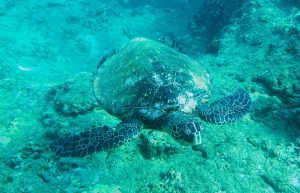
Keep our sea life safe and healthy. Look but don’t touch.
No touchy!
It is illegal to touch or harass sea turtles, monk seals or any other marine animals, based on both the Endangered Species Act and the Marine Mammal Protection Act. A hotline is utilized across the island to report any turtle or seal that comes up to sun themselves across the islands. Within minutes, you will see volunteers stringing yellow caution tape up and around these protected animals. Take this law seriously, as it comes with a severe fine and possibly jail time. Show courtesy, and wisdom, by staying a respectable distance away.
Find a sidewalk
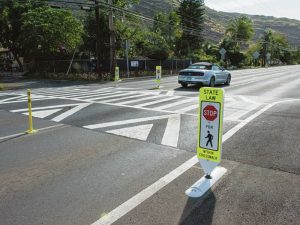
To reduce the numerous car/pedestrian accidents, and slow traffic flow, raised crosswalks are being installed across the islands (Image courtesy of Recovery Law Center)
Jaywalking is illegal all over the islands, but moreover, due to road and traffic conditions, it is extremely dangerous. This not only includes Waikīkī and downtown Honolulu, where police officers will be more than happy to slap offenders with an costly ticket, but throughout the island. Farrington Highway, which covers the far west side of the island, is considered the most dangerous roadway in the state. On the North Shore, where parking is severely limited, visitors anxious to visit some of the amazing beaches park where ever possible and end up playing a game of chicken with the thousands of cars on the road. Use your head, and the closest sidewalk. Even then, make sure that you look to see that the driver clearly sees you and is slowing. Don’t take anything for granted.
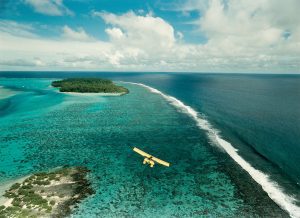
Our Pacific shores are home to one of the most diversified and rare collection of sea live in the world.
Protect our fragile shoreline
The beautiful coral reefs that surround each island are protected by a number of laws and institutions. So, follow these simple rules:
- Do not stand on, break-off or take coral. Not even a little piece. No. Nope. Nada. The ecosystem of our corral reefs have been pummeled by both over zealous and unenlightened tourists, discarded plastics and global warming. Live coral is extremely fragile. Help Hawai’i preserve their precious and unique resources.
- Use only ‘reef safe’ sun protection. That’s a law! For more information visit Hanama Bay State Park.
- Single use plastics, including straws, spoons, knives, and forks, are forbidden. Polystyrene (foam) food containers and plastic bags have been banned since the beginning of 2021. Local and chain stores carry bamboo or biodegradable plasticware and offer paper bags for carry out only.
Restricted items as you leave Hawai’i
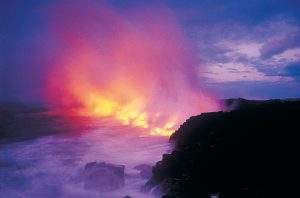
Image courtesy of The Hawaiian Journey, at the Polynesian Cultural Center
Do not, repeat… Do NOT, try to bring lava back home with you (or to your hotel room, car, backpack, etc.) Not only is it incredibly illegal, but you stand a chance of insulting the Goddess Pele. I’m not making this up! Many tourists have sent back coral to various departments, hotels, and cultural entities begging them to return it to the sea to end the bad luck they were experiencing since returning from the islands.
Sand of any color (including black, green or red). Again, incredibly illegal… and rightly so. The rare colored sands of Hawai’i are a prime target for both tourist and commercial operations, Hawai’i is taking a stand before they become completely depleted. Of course, this does not include sandy shoes, feet, towels, etc. But don’t be packaging it up for a souvenir. Even a teaspoon purposefully brought on-board is subject to fines so large, your dream vacation will become your worst nightmare.
According to the US Department of Agriculture, Here are a few more items:
- Berries of any kind, including coffee and coffee-related materials
- Improperly stored fish, meats or certain perishables
- Certain plants, such as bromide, cacti and soil
- Live insects and snails
- Sugarcane
- Swamp cabbage
- Raw sweet potato
- Mock orange
- (See USDA list for more)
IMPORTANT NOTE: This USDA provides the most comprehensive list, however, they incorrectly list ‘sand’ as allowed. This is definitely not true. They may have no restrictions, but due to the disappearing shoreline, and rampant popularity of our colored sands, the State of Hawai’i has imposed large fines for any purposeful removal of sand (meaning you don’t need to panic over sand on your shoes, but that little container you meant to keep as a memento might just cost you a few hundred thousand dollars). Here is a great article to explain why.
…but definitely do this!
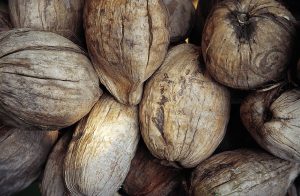
Coconuts are legal to take home from your Hawaiian vacation
There are some surprisingly wonderful items you might think are prohibited, but are not:
Allowable (with reasonable restrictions) according to the US Department of Agriculture
- Coconut
- Coffee: Travelers are permitted to bring back unlimited quantities of roasted coffee or green (unroasted) coffee beans without restriction through any continental U.S. port of entry.
- Commercially canned or processed foods, including processed fruits and vegetables
- Accepted processing methods include cooking, drying, or freezing. If freezing, all fruits must be frozen solid at the time of inspection. Frozen mango must be without seeds.
- Dried seeds and decorative arrangements
- Fresh flowers, leis, and foliage, except any citrus or citrus-related flowers, leaves, or other plant parts, as well as jade vine or Mauna Loa
- Hinahina (Spanish moss)
- Irish or white potatoes
- Fresh pineapple
- Treated fruit, such as papaya, abiu, atemoya, banana, curry leaf, dragon fruit, longan, lychee, mangosteen, rambutan, starfruit, and sweet potato
- These fruits must be treated at a USDA-approved facility and packed in sealed boxes that are properly marked and stamped.
- Plants and cuttings
- Some states may require rooted plants to be certified by the Hawai’i Department of Agriculture before they may be moved to the U.S. mainland.
- Rocks and stones
- Seashells, not land snail shells
- Seed leis and seed jewelry
- Wood (including driftwood and sticks) and wood roses (dried)
Please note: Although the USDA FAQ sheet listed above includes ‘beach sand’ on their site, this does not diminish the fact that the State of Hawai’i has passed a law making it illegal. So, no sand.
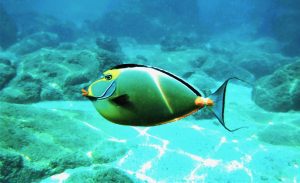
The Humuhumunukunukuapua’a is native to the Hawaiian reef
In Summary…
We hope you find this information on the do’s and don’ts for your Hawai’i vacation useful and enlightening.
The Polynesian Cultural Center is a strong supporter of preservation and restoration efforts across our islands. Hawai’i is an eco-center of ocean, island and volcanic importance. By following these guidelines, we invite you to become a part of the solutions put in place to allow our islands to thrive.
Here are some other useful articles as you plan your trip to Hawai’i:
The Right Shoes for the Right Hawaiian Activities
Planning Your First Family Trip to Hawai’i
Bio of Nina S. Jones, Blogger for the Polynesian Cultural Center
 Nina Jones, a mainland gal from way back, is now a transplanted Islander. With her husband of 45+ years, she has been thrilled to live in the beautiful village of Laʻie for the past 9 years. Her hobbies include swimming, traveling, studying and writing about what she is learning from the various Polynesian cultures. Her blogs focus on their history, beliefs, practices and – as an added bonus – delicious food! To her, Polynesia is not just a place to visit, it is a way to live and she is very honored to be able to be a part of their amazing world.
Nina Jones, a mainland gal from way back, is now a transplanted Islander. With her husband of 45+ years, she has been thrilled to live in the beautiful village of Laʻie for the past 9 years. Her hobbies include swimming, traveling, studying and writing about what she is learning from the various Polynesian cultures. Her blogs focus on their history, beliefs, practices and – as an added bonus – delicious food! To her, Polynesia is not just a place to visit, it is a way to live and she is very honored to be able to be a part of their amazing world.

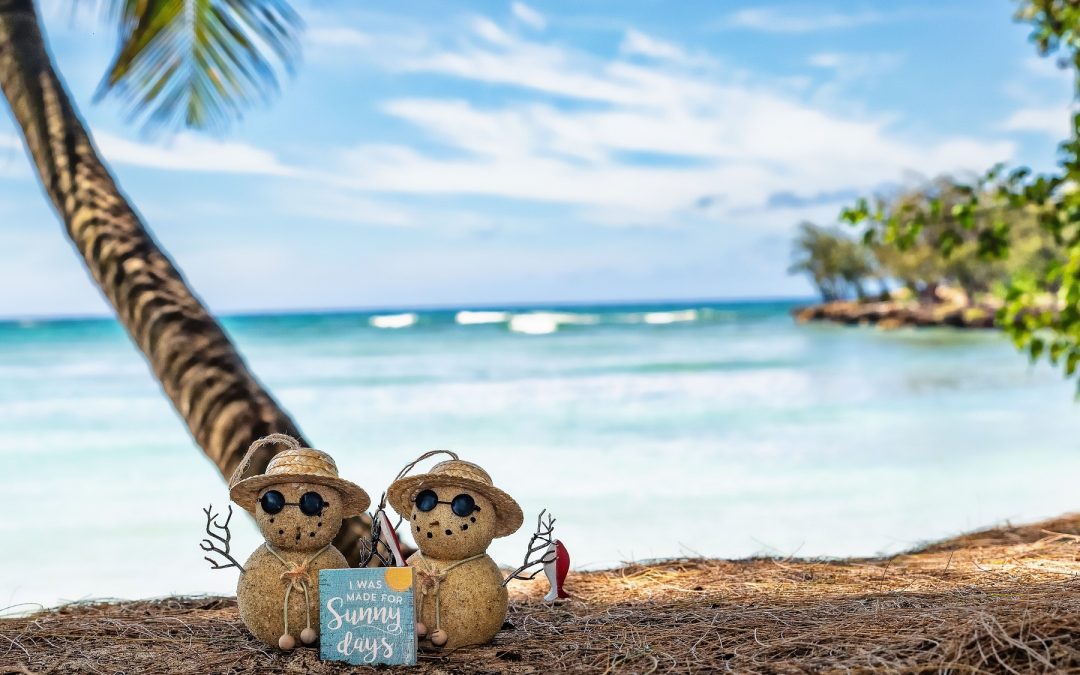
Recent Comments